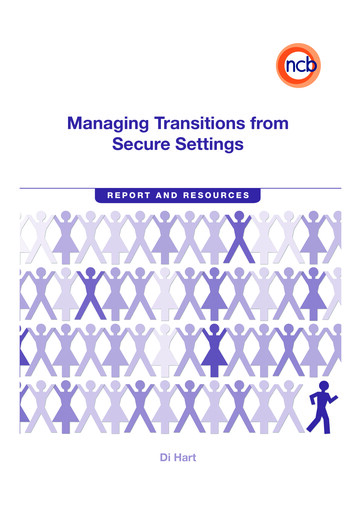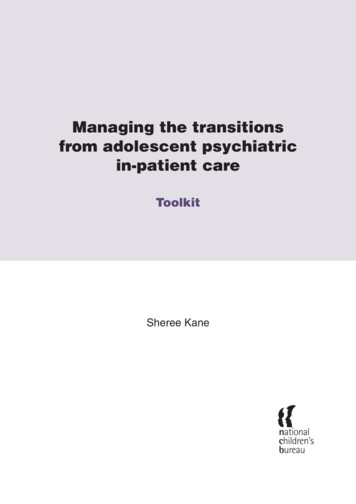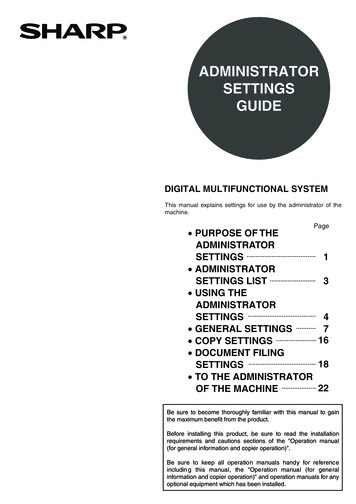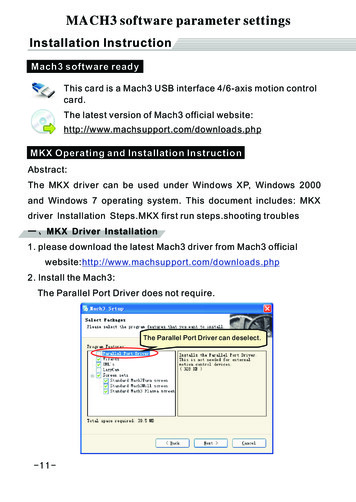
Transcription
Managing Transitions fromSecure SettingsREPORT AND RESOURCESDi Hart
Managing transitionsfrom secure settingsReport and resourcesDi HartMTRA SECU Book PMS261M.indd 103/03/2009 11:24:58
Managing transitions from secure settingsNCB’s vision is a society in which all children and young people are valued and theirrights are respected.By advancing the well-being of all children and young people across every aspect oftheir lives, NCB aims to: reduce inequalities in childhood ensure children and young people have a strong voice in all matters that affect theirlives promote positive images of children and young people enhance the health and well-being of all children and young people encourage positive and supportive family, and other environments.NCB has adopted and works within the UN Convention on the Rights of the Child.Published by NCB.NCB, 8 Wakley Street, London EC1V 7QETel: 0207 843 6000Website: www.ncb.org.ukRegistered charity number: 258825NCB works in partnership with Children in Scotland (www.childreninscotland.org.uk)and Children in Wales (www.childreninwales.org.uk). NCB 2009ISBN: 978-1-905818-48-8British Library Cataloguing in Publication DataA catalogue record for this book is available from the British LibraryAll rights reserved. No part of this publication may be reproduced, stored in a retrievalsystem or transmitted in any form by any person without the written permission of thepublisher.The views expressed in this book are those of the authors and not necessarily thoseof NCB.Typeset by Saxon Graphics Ltd, DerbyPrinted in the United Kingdom by Hobbs the Printers Ltd, Totton,Hampshire. NCB 2009MTRA SECU Book PMS261M.indd 2Cert no. SA-COC-1530203/03/2009 11:25:31
Photo reproduced with kind permission of the Marine Accident Investigation Branch (MAIB).Managing transitions from secure settingsFor a boat to move smoothly through a lock, the water on the other side needsto be at the same level. Does the same principle apply to young peoplemaking the transition from a secure setting that they receive the same levelof support on both sides of the gate? The findings of the Managing TransitionsProject suggest that this smooth transition is achievable, but is not happeningconsistently enough. NCB 2009MTRA SECU Book PMS261M.indd 3303/03/2009 11:25:31
Managing transitions from secure settingsContentsAcknowledgementsForeword56Part 1: The Managing Transitions from Secure Settings ProjectAim of the Project 8Project methods 8The young people 9Project findings 13Key messages 24Part 2: Assessment and planning 25Briefing: The secure estate 27Briefing: Care planning for looked after childrenBriefing: Leaving care services 37830Part 3: What is an effective transition? 39Towards a conceptual framework 39Paper: Promoting resilience: messages from research 44NCB Highlight 235: Resettlement of young people leaving custodialestablishments 49Part 4: Practice tools 57Briefing: Conceptual model needs, outcomes, services and reviewExercise: Identifying need 59Exercise: Auditing transition plans 62Flow chart: A model for joint planning and practice 6757Part 5: Conclusion and recommendations 68A twin-track approach to managing the transition of children from securesettings 70Part 6: Resources 71References and further reading 71Useful organisations and websites 73 NCB 2009MTRA SECU Book PMS261M.indd 4403/03/2009 11:25:31
Managing transitions from secure settingsAcknowledgementsI would like to thank the following for their help with this Project: The establishments that took part in this Project, and the individual staffmembers who gave up their time to assist me and to reflect openly on thestrengths and frustrations of current practice. The six young people who allowed me to follow them on their journeys fromthe secure setting to their communities, and who shared their views andexperiences. Their family members, who encouraged the young people to take part in theProject, and who also shared their hopes and anxieties about the future. The social workers, YOT workers and care staff working with the youngpeople, for contributing their views on the transition process and how itcould be improved. Members of the advisory group and participants in the invited seminar whocontributed their expertise, knowledge and ideas. NCB 2009MTRA SECU Book PMS261M.indd 5503/03/2009 11:25:32
Managing transitions from secure settingsForewordI’ll miss it even though it’s took my freedom away.(Young person about to leave a secure children’s home)This resource is designed to support practice with children and young peoplewho are moving on from, or within, the secure estate. A companion resource isavailable for those managing transitions from adolescent psychiatric in-patientfacilities. It is based on the Managing Transitions from Secure and PsychiatricSettings Project funded by the Department of Children, Schools and Families(DCSF) from April 2007 to March 2008. The aim of that Project was tohighlight the needs of young people in these specialist settings and to identifyways to improve transitional planning.Although secure and psychiatric settings have different processes and operatewithin different systems, common themes can be identified in terms of theexperiences and needs of the children and young people within them as wellas in the challenges faced by secure establishment staff as they try to supportthe transition process. The Managing Transitions from Secure Settings Projectaimed to identify these themes and to explore approaches towards improvingoutcomes, including the transfer of lessons about effective transition planningfrom other settings.The legislation and policy framework covered by the briefings was up to dateat the time of writing (Spring 2008), but there are a number of new initiativeson the horizon, including the Children and Young Person’s Bill 2008 and theYouth Crime Action Plan 2008.Part 1 describes the Project: its aims and methodology, the experiences of anumber of young people in transition, a summary of the findings and the keymessages.Part 2 provides background information on the legal and policy context withinwhich secure settings operate, and describes the respective planning systemsand young people’s entitlements.Part 3 explores the ingredients for effective transitions, including thoseidentified within the literature, on both resettlement from custodial settings andyoung people leaving the care system.Part 4 provides a selection of practice tools designed to support transitionplanning, including a proposed model for effective transition planning.Part 5 makes recommendations for policy-makers, researchers,commissioners, inspectors, secure establishments, youth offending teams andchildren’s services based on the Project’s findings and the priorities identifiedat an invited seminar. This seminar, held in May 2008, provided an opportunity NCB 2009MTRA SECU Book PMS261M.indd 6603/03/2009 11:25:32
Managing transitions from secure settingsfor invited representatives from the above stakeholders to comment on theProject’s findings and to contribute their views about how to improvetransitions.Part 6 offers additional resources, including further reading and a list of usefulorganisations and websites. NCB 2009MTRA SECU Book PMS261M.indd 7703/03/2009 11:25:32
Managing transitions from secure settingsPart 1:The Managing Transitions fromSecure Settings ProjectAim of the ProjectThe aim of this Project was not to replicate the findings of other projects onresettlement services. The recent work done by both the Reset Project and thePrince’s Trust has already demonstrated the value of providing intensivesupport to young people following their release from custody as well as theimportance of providing suitable housing, and education, training oremployment (ETE) opportunities (Reset 2007; Prince’s Trust 2008). Instead,its aim was to illustrate some of the individual challenges faced by youngpeople leaving secure settings in a variety of circumstances. This would serveas a snapshot of current practice in order to identify how well currentarrangements are working and to reflect the views of the young people andthose trying to support them in their move back into the community or toanother secure setting. This resource aims to help practitioners to think aboutthe needs of young people in transition within the secure estate in a way thattranscends the focus on systems and services that can be a feature of currentpractice. Its underlying philosophy is that effective transition planning shouldbe driven by the individual needs of young people, not the services that areavailable. Although it contains some practical tools and information briefings,these are designed to support reflective practice rather than to offer a formulaabout how to ‘do’ transition work.Project methodsThe Project worked with three secure establishments in order to representeach type of setting within the secure estate: a young offender institution(YOI), a secure training centre (STC) and a secure children’s home (SCH). Arange of key staff from each establishment was invited to contribute theirviews on the needs of the young people in their care and to comment onexisting arrangements for planning to meet those needs. The focus was on thework that is needed to support a smooth transition back to the community or,for some young people, to another setting, and it was recognised that thisprocess should begin as soon as a young person entered the establishment.Transition or ‘resettlement’ planning, as it is commonly referred to within thecriminal justice system, relies on a case management approach that is basedon an assessment of individual need. Some of the concepts underpinning thisapproach are considered in more detail in Part 3.Each establishment identified a number of young people who were due toleave within the next month; they were approached to see if they would beprepared to participate in the Project. For those young people under the age of16, consent was also sought from a parent. The intention was to include ayoung person who was in the secure children’s home on ‘welfare’ grounds,under section 25 (s25) of the Children Act 1989, rather than through thecriminal justice system, but no suitable young person could be identified duringthe Project’s timescale. There are very few such children and none of those in NCB 2009MTRA SECU Book PMS261M.indd 8803/03/2009 11:25:32
Managing transitions from secure settingsthe SCH at the time the Project was taking place were considered to be suitablebecause of their level of disturbance. Staff did, however, discuss the respectiveplanning systems that apply to both categories of young people. In terms of thecare provided by the establishment, there are no significant differences basedon their legal status: the aim is to identify and meet the young people’s needs.Two young people in each setting agreed to contribute to the learning process.These young people had a range of different ‘care’ statuses: some weresubject to care orders, others had been accommodated by the local authorityon a voluntary basis prior to admission. All six young people were subject to aDetention and Training Order (DTO). Each young person was interviewed atthe start of the Project to elicit their views about the factors that would helpthem to make a positive transition back into the community. The youngperson’s records were also examined. Where possible, the pre-releasemeeting and for one young person, his Looking after Children (LAC) review were observed. The career of the young person during their time inplacement and following their release into the community was tracked. Afurther interview was conducted with each young person between one andthree months after their release. Key people within the professional networkssupporting the young person were interviewed, including YOT (youth offendingteam) workers, social workers and care staff.An advisory group was convened to support both the secure and psychiatricstrands of the Project. The group provided advice on additional sources ofinformation, commented on emerging themes and engaged in discussionabout how transition planning could be improved. Participants also madesuggestions for materials to include in this resource.In May 2008, an invited seminar of policy-makers, relevant inspectorates,national stakeholders and representatives from the participatingestablishments was convened in order to consider the Project’s findings.The objectives were to: feed back the findings of the Managing Transitions Project hear about the proposals regarding the resettlement of young offenders inthe forthcoming Youth Crime Action Plan from the Joint Youth Justice Unit share thoughts and ideas on the critical issues to be tackled in policy,research and practice.The young peopleThe names of the young people have been changed to protect their identities.MichaelMichael was 14 years old and serving an eight-month DTO. He had beenaccommodated on a voluntary basis since the age of seven, along with hissiblings, because of his mother’s abandonment of the family. After a relativelysettled period in foster care, and following his mother’s reappearance andcontact with his older brothers, Michael began to display disturbed anddisruptive behaviour. With the foster placement disrupted, Michael became NCB 2009MTRA SECU Book PMS261M.indd 9903/03/2009 11:25:32
Managing transitions from secure settingsincreasingly out of control: he absconded from a variety of placements andwent missing for days on end, abused alcohol and committed offences. Hewas considered to be vulnerable and the local authority had consideredmaking an application to place him in an SCH on welfare grounds, but he wassentenced to a DTO before this could happen. The local authority did initiatecare proceedings and Michael was subject to an interim care order. The finalhearing was due to be held a few days before his release date. Michael’smother contested the order: she wanted him to be cared for by a familymember whereas the local authority wanted to place him in a residentialchildren’s home where he would have access to therapeutic support. Thismeant that firm plans could not be made for Michael’s discharge.Michael settled extremely well in the secure setting. Having been out of schoolbefore his sentence, he enjoyed the educational opportunities and cooperatedwith the regime.The Family Proceedings Court postponed Michael’s final hearing for sixmonths so that the suitability of the family placement could be assessed. Hewas released on an interim care order to a small children’s home many milesfrom the family home. However, with support, his mother was able to visitfrequently. At the follow-up interview, Michael was doing well. He had notre-offended or absconded, was complying with his licence and was attendingeducation on the premises.HannahHannah was 16 years old and serving a DTO. She was also a looked afterchild, having been on a full care order since the age of 12. She had extremelycomplex needs, including gender dysmorphia, learning difficulties, ADHD anda history of self-harm. Before sentence, she had been living in a children’shome where her behaviour had become increasingly disturbed and disruptive.Hannah also enjoyed her time in the secure setting and her behaviour wasmuch calmer and more under control. She forged strong relationships withstaff and was apprehensive about leaving the establishment. The plan was forher to move to a different children’s home from the one she had been inpreviously, with a view to transferring back when they had a vacancy. Hannahwas 16 at the time of her release and keen to work until she could obtain aplace at college.At the follow-up interview, Hannah was living in the new children’s home andno longer wished to move back to her previous placement. She had committedsome minor breaches of her licence through returning late to the children’shome, but these had not been considered serious enough to warrant her beingrecalled. There had been some minor incidents of self-harm, but no offences,and it was generally acknowledged that Hannah was calmer than she hadbeen before her sentence.Hannah had been unable to secure work or a college placement, and wasunhappy about the fact that her placement was not in her home town andtherefore not near to her family. The plan was to move her towards semiindependent accommodation in her home town. NCB 2009MTRA SECU Book PMS261M.indd 101003/03/2009 11:25:32
Managing transitions from secure settingsJohnJohn was 14 and serving a 12-month DTO. John’s father had a residenceorder, but had been unable to cope with his behaviour and had returned him tohis mother. She too found it difficult to cope and had asked for help fromchildren’s social care services. John had been in the secure establishmentbefore on remand, but settled much better during this stay, modelling himselfon some of the better behaved trainees. He engaged well with education in thesecure setting and was determined to stay out of trouble when he wasreleased. The plan was for him to live with his mother in her new boyfriend’sflat and to attend a pupil referral unit (PRU) on a part-time basis. He was to bereleased early, subject to a curfew.At the follow-up interview, it was found that John had been returned to thesame setting for breaching the terms of his licence. He had also been arrestedfor a new offence and was waiting to go to court. John said that he had lost thetimetable given to him by his YOT worker; he had tried to remember hisappointments but had got the time or venue wrong on two occasions. He hadalso missed school once because he was ill, but had not phoned them. Johnfelt that these infringements were his responsibility. He felt that everything hadbeen ‘okay’ when he was out, and that his behaviour and school attendancehad been much better than before. He had also complied with his curfew. Asocial worker had visited the family but said there was no need for ongoinginvolvement. John seemed lower in mood and was less optimistic about hisfuture than he had been when he was first interviewed.ChelseaChelsea was 16 and serving 10 months in total for a breach of a previousDTO and a new sentence. She had been in care since the age of 15, whichshe felt was her own responsibility for ‘ruining her family’. Chelsea wanted toreturn home to her mother, but was unclear whether this could happen. Shehad been living in independent accommodation provided by children’s socialcare services before her sentence, but was unsure where she would beplaced on her release. There was a possibility of bed and breakfast (B B)accommodation, but Chelsea said that her YOT worker was arguing againstthis. Shortly before she was due for release, and having reached the age of17, Chelsea was transferred to a YOI because of behavioural problems.At the follow-up interview, Chelsea was back in the YOI. She had initially hadher own flat, provided by children’s social care services. Because thisplacement was in a different local authority, she had been transferred to a newYOT supervisor. The placement was identified less than two days before herrelease and the planned Intensive Support and Supervision Programme(ISSP) was not available so she was offered support from a Resettlement andAfter Care Programme (RAP). The conditions of her licence required her to beelectronically tagged and to observe a curfew. Chelsea lost the flat followingcomplaints from neighbours and was moved to B B where she felt unhappy.She found it difficult to comply with the tag and curfew because it meant shehad to stay in, alone, in an environment she found unpleasant. She broke hercurfew on New Year’s Eve and was arrested for a new offence. Chelsea hadbeen on an ETE scheme and was hoping for a performing arts placement. She NCB 2009MTRA SECU Book PMS261M.indd 111103/03/2009 11:25:32
Managing transitions from secure settingswas unsure what would happen as a result of the new charges against her, orwhat the plans would be following her eventual release.DarrenDarren was 15 and serving an 18-month DTO when first seen. He was to turn16 before his release. He had been in voluntary care for a year prior tosentence because of conflict with his father and had been living in a children’shome. He had been permanently excluded from school and was due to start ata PRU, but was sentenced before he could take up the place. In spite of thefact that he was not technically looked after while in custody, his local authoritywere continuing to plan for him as if he were and had agreed to resume careof him on his release, although no placement had been identified. Thechildren’s home and PRU also maintained contact with him. Darren hadre-engaged with education in the secure setting and wanted to take GCSEs.The PRU were liaising with the establishment and were sending work in forhim. Darren’s behaviour had been excellent throughout his sentence and itwas planned that he would be released early and placed on an ISSP.At the follow-up interview, Darren was doing well. He had returned to hisprevious children’s home and was supported by ISSP staff, a YOT worker andsocial worker, all of whom he already had an established relationship with.Darren had found it difficult to adjust to being back in the community, feeling‘spaced out’ and unable to sleep, but he had managed to overcome this andwas engaged in the detailed programme of activities provided for him.Relationships with both parents and his girlfriend were positive, and he wasnot finding it difficult to stay out of trouble. He felt this was partly due to beingmore settled and partly because he was ‘growing out of it’.MarkMark was 17 and serving a six-month DTO. He had several previoussentences this was his fourth DTO and he was considered to be apersistent and prolific offender. He had missed most of his secondaryeducation because of exclusions and periods in custody. Mark came from alarge and close family, but his mother had difficulty in controlling his behaviour.He had never been a looked after child, but shortly before his last sentence ithad been arranged that he would live with a family friend. This had beenworking well and it was planned that he would return there on his release.Mark had participated well in the regime and presented no problems while incustody. He was keen to work and was disappointed that his application fortemporary release to attend a fork-lift truck course had been turned down ashe felt that work was key to staying out of trouble.At the follow-up interview, Mark was living with the family friend and itappeared to be going well. His YOT worker had fought for him to access thefork-lift truck course and he had just started that. In spite of his history ofprolific offending, Mark had managed to stay out of trouble and to comply withhis licence. There was a sense of optimism that he may, to some extent, haveoutgrown his offending. NCB 2009MTRA SECU Book PMS261M.indd 121203/03/2009 11:25:32
Managing transitions from secure settingsSummaryIt is clear that some of the young people had achieved more successfuloutcomes than others. Two young people had been ‘breached’ and returnedto custody; two were doing well and there was a sense of optimism about thefuture; two were somewhere in-between: they were doing alright, but werenot completely settled. Although it is impossible to draw any firm conclusionsfrom such a small sample of young people, participants contributed theirviews about the factors that can influence outcomes. These will now bedescribed.Project findingsThe Youth Justice Board Framework (YJB 2006a) identifies the following asthe pathways for effective resettlement: case management and transitions accommodation education, training and employment health substance misuse families finance, benefits and debt.Case management is the process that coordinates all aspects of the work. Theelements are described as: a thorough assessment of the risk factors associated with offending and theindividual needs of each young person a single-sentence plan tailored to address the identified risks and needs ofeach young person that is focused from the outset on promoting theirsustainable and safe return to the community continuity of overseeing and support from the YOT coordination of the contributions of the different agencies, ensuring thatservices are sustained beyond the end of the licence timely exchange of information.How was this framework applied in respect of the six young people within theProject?An integrated approach to case managementInvolvement of external agenciesCurrent children’s policies, whether in the youth justice or welfare sphere,emphasise the importance of a coordinated and multi-agency approach tomeeting children and young people’s needs. Participants in this Project wereinvited to comment on the way this worked generally and in relation to the sixyoung people involved in the Project. Opinions were mixed, but no-one NCB 2009MTRA SECU Book PMS261M.indd 131303/03/2009 11:25:32
Managing transitions from secure settingsthought the system was working seamlessly in the way envisaged by theFramework for Resettlement. Staff working in secure settings in particularexperience huge frustration in engaging external agencies, whether this is toprovide information when young people arrive, to meet their needs during theirstay or to plan for their transition from the establishment:Some are good, some are awful. Distance plays a part in it. Educationdon’t come in – it’s hard to find out if they still have a role – they don’tget back to you. Local CAMHS – if they’re already involved, might do.It’s really, really difficult. It has happened where the placement willcome in but they won’t continue intervention work – particularly if theyhave started work with CAMHS – they won’t come in – and they won’tpay for it. Do we refer to our psychiatrist and start again?Considerable energy had to be expended to provide a coordinated plan,particularly where the young person was looked after and different systemswere therefore in operation. The secure children’s home had designated aspecific resettlement post to undertake this coordination role and it was clearlyworking well. Apart from the intended consequence of achieving moreeffective planning, the postholder was also perceived by the young people asa bridge to the outside world. The importance of this will be discussed later inthis document. Staff within the other settings also took on a casework function,but it does seem that this essential role cannot be fulfilled without beingformally designated.Nature of the plansEven with active case management, there are limits to how much securesettings can influence the quality of the plans that are made. The notion thatevery young person has an individualised plan based on their assessed needsis not fully realised. Staff from the establishments said:We try to make it as individualised as possible here – but there arelimited resources. When they’re released, they slot them into whateveris going.It depends – we can recommend this, this and this but it comes downto what they’ve prepared.This is reflected in other comments made by staff in the establishments aboutthe lack of specificity within many release plans:They’re mixed – you can get basic plans done very easily, e.g. home,reporting to YOT – but the interventions and details are not there.A ‘good plan’ would:Let the young person know exactly what is in place for them and thetimescales and accountability: who’s going to make sure it happens. NCB 2009MTRA SECU Book PMS261M.indd 141403/03/2009 11:25:32
Managing transitions from secure settingsContribution of secure settingThere was some frustration among staff in the secure settings about their lackof influence over the young people’s plans once they were released. This didseem to be a wasted opportunity, particularly where they had gained a goodunderstanding about the young person’s needs. One of the residential workerswho was caring for a young person after his release said:I would have liked more information from the establishment about whathelps/hinders/kicks him off.There appears to be a gap in the assessment and planning systems in relationto the contribution that can be made by the secure setting, within both thewelfare and youth justice systems. Not only do external assessments notnecessarily follow the young people into the setting, but the work undertaken bythe establishment does not necessarily inform what happens to the youngpeople next. In theory, secure settings will feed into the updating of Asset (theassessment and planning system for young offenders), but the process for thisis not entirely clear. Most establishments have devised their own assessmentand care-planning documentation to keep track of the work they are doing but,again, it is unclear how this is communicated to external agencies. At worst, thiscan mean that the gains made by young people are not taken into account.Those who have re-engaged with education and caught up are not returned tomainstream education because their plan is based on how they were before.There could be more done on updating Asset.(Staff member, STC)There’s no real continuity in interventions – there’s not really theinformation there.(YOT worker)Transition within the secure estateTransition planning is focused almost entirely on the young person’s releaseinto the community, yet a significant number of young people move within thesecure estate. This may be a planned move, e.g. because they have reachedthe age to transfer to a facility for young adults or older young people, orbecause they require input from a specialist unit. Where this was the case,staff in the settings made real efforts to get information about the newplacement – but it is not always available:There’s not a great deal of information – particularly from YOIs. I’m inthe
Managing transitions from secure settings Report and resources Di Hart MMTRA_SECU_Book_PMS261M.indd 1TRA_SECU_Book











